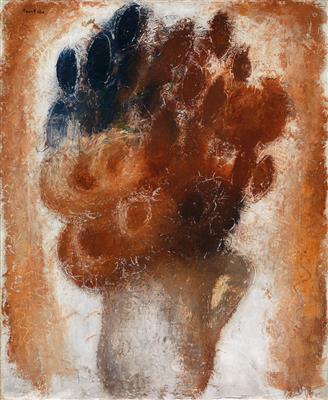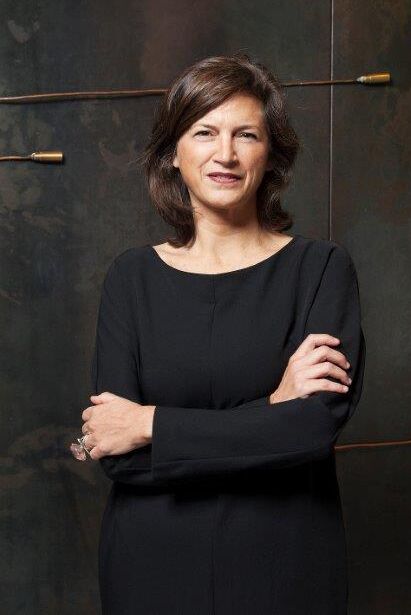Jean Fautrier *

(Paris 1898–1964 Chatenay)
Bouquet de fleurs, 1930, signed Fautrier, oil on canvas, 73 x 60 cm, framed, (PP)
The work will be included in the forthcoming Catalogue raisonné, which is currently being compiled by Marie-José Lefort.
Provenance:
Collection Dominique Fautrier, Paris
Private Collection, France
The present flower bouquet, executed in 1930 or thereafter, is one of the last to have been painted by Fautrier. The composition of this work goes beyond the figurative aspect of his early paintings of flower bouquets. The gradual vanishing of forms and the use of materials in this composition herald the Informalism that would characterise the artist’s work shortly afterwards. Fautrier works more and more on materials and their perception, and less on formal exactness.
His creative phases include a période noire (‘black period’), where colour gushes out of a dark background, and a période grise (‘grey period’), in which the colours of the subject shape the bright background in chromatic relief. The “scarification marks” executed with the back of the brush draw the outline of the jug and of the flowers and animate the space surrounding them, corroborating this aspect of matter and movement. The details and subtleties of this painting are such that its full poetic quality could not be appreciated on the basis of a photograph. The viewer must have the original before him in order fully to discern its aesthetic meaning. The colours are sublime. Some flowers ooze light whilst others seem to absorb it. An aura composed of a subtle mélange of light shades of grey, touches of yellow and different nuances of brown, surrounds the bouquet like an alcove with a bright grey background. Wavy patterns scratched in the pictorial material border the flowers along vertical lines, in the guise of a frieze that frames the subject in order to highlight it and accentuate its central position. Like a painted frame or theatre curtains opening on the flower bouquet, this composition accentuates the presence, in the foreground, of the subject offered to the viewer’s admiration. The bouquet takes pride of place in a vase serving as the setting on which the elements of the floral body are spread out. The entire structure of the painting is orchestrated in such a way as to suggest something beyond a simple bouquet of flowers, in order to push our imagination to grasp the work in its entirety. Thus, every viewer interacts differently with the pictorial scene depending on his point of view.
The different shades of brown, the circular forms and the “scarification marks” scraped in a thick layer of paint combine two major aesthetic trends of the 20th century: Western art and a tribal source of inspiration derived from a rare Luluwa mask that Fautrier purchased from his art dealer Paul Guillaume. As a result, this painting from the 1930s goes beyond the echo of its title. It does not look like the bouquets painted by any other artists, on the ground of its aesthetic appearance, its use of material and its conceptualisation. The number of documented canvases executed by Fautrier that are partly based on a primitive source of inspiration is very small. This painting style, loaded with influences and history, belongs to a group of works that are very much sought-after both among collectors of modern and contemporary art and among collectors of tribal art.
© Nazim Kadri, 2014, extract inspired by the book “Fautrier Artiste, Fautrier Collectionneur”, in preparation.
Expert: Mag. Patricia Pálffy
 Mag. Patricia Pálffy
Mag. Patricia Pálffy
+43-1-515 60-386
patricia.palffy@dorotheum.at
22.05.2014 - 19:00
- Dosažená cena: **
-
EUR 55.200,-
- Odhadní cena:
-
EUR 45.000,- do EUR 65.000,-
Jean Fautrier *
(Paris 1898–1964 Chatenay)
Bouquet de fleurs, 1930, signed Fautrier, oil on canvas, 73 x 60 cm, framed, (PP)
The work will be included in the forthcoming Catalogue raisonné, which is currently being compiled by Marie-José Lefort.
Provenance:
Collection Dominique Fautrier, Paris
Private Collection, France
The present flower bouquet, executed in 1930 or thereafter, is one of the last to have been painted by Fautrier. The composition of this work goes beyond the figurative aspect of his early paintings of flower bouquets. The gradual vanishing of forms and the use of materials in this composition herald the Informalism that would characterise the artist’s work shortly afterwards. Fautrier works more and more on materials and their perception, and less on formal exactness.
His creative phases include a période noire (‘black period’), where colour gushes out of a dark background, and a période grise (‘grey period’), in which the colours of the subject shape the bright background in chromatic relief. The “scarification marks” executed with the back of the brush draw the outline of the jug and of the flowers and animate the space surrounding them, corroborating this aspect of matter and movement. The details and subtleties of this painting are such that its full poetic quality could not be appreciated on the basis of a photograph. The viewer must have the original before him in order fully to discern its aesthetic meaning. The colours are sublime. Some flowers ooze light whilst others seem to absorb it. An aura composed of a subtle mélange of light shades of grey, touches of yellow and different nuances of brown, surrounds the bouquet like an alcove with a bright grey background. Wavy patterns scratched in the pictorial material border the flowers along vertical lines, in the guise of a frieze that frames the subject in order to highlight it and accentuate its central position. Like a painted frame or theatre curtains opening on the flower bouquet, this composition accentuates the presence, in the foreground, of the subject offered to the viewer’s admiration. The bouquet takes pride of place in a vase serving as the setting on which the elements of the floral body are spread out. The entire structure of the painting is orchestrated in such a way as to suggest something beyond a simple bouquet of flowers, in order to push our imagination to grasp the work in its entirety. Thus, every viewer interacts differently with the pictorial scene depending on his point of view.
The different shades of brown, the circular forms and the “scarification marks” scraped in a thick layer of paint combine two major aesthetic trends of the 20th century: Western art and a tribal source of inspiration derived from a rare Luluwa mask that Fautrier purchased from his art dealer Paul Guillaume. As a result, this painting from the 1930s goes beyond the echo of its title. It does not look like the bouquets painted by any other artists, on the ground of its aesthetic appearance, its use of material and its conceptualisation. The number of documented canvases executed by Fautrier that are partly based on a primitive source of inspiration is very small. This painting style, loaded with influences and history, belongs to a group of works that are very much sought-after both among collectors of modern and contemporary art and among collectors of tribal art.
© Nazim Kadri, 2014, extract inspired by the book “Fautrier Artiste, Fautrier Collectionneur”, in preparation.
Expert: Mag. Patricia Pálffy
 Mag. Patricia Pálffy
Mag. Patricia Pálffy
+43-1-515 60-386
patricia.palffy@dorotheum.at
|
Horká linka kupujících
Po-Pá: 10.00 - 17.00
kundendienst@dorotheum.at +43 1 515 60 200 |
| Aukce: | Moderní |
| Typ aukce: | Salónní aukce |
| Datum: | 22.05.2014 - 19:00 |
| Místo konání aukce: | Wien | Palais Dorotheum |
| Prohlídka: | 10.05. - 22.05.2014 |
** Kupní cena vč. poplatku kupujícího a DPH
Není již možné podávat příkazy ke koupi přes internet. Aukce se právě připravuje resp. byla již uskutečněna.

